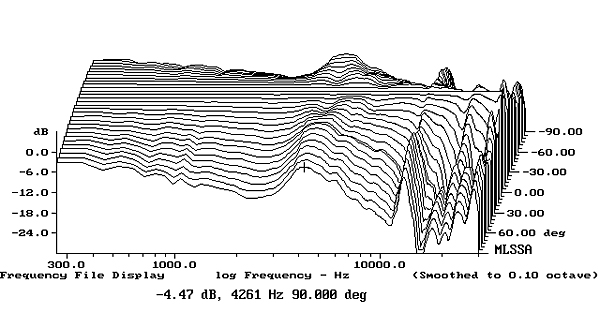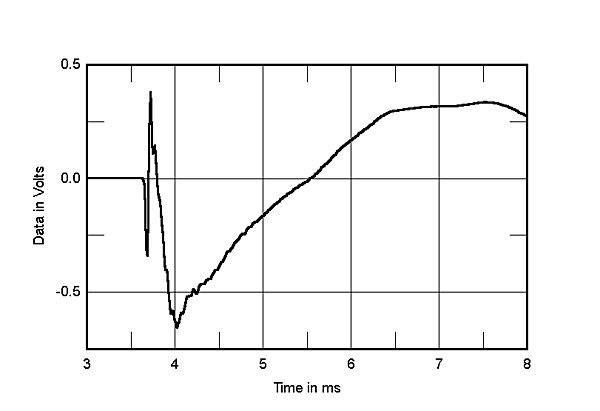| Columns Retired Columns & Blogs |
Definitive Technology StudioMonitor 55 loudspeaker Measurements
Sidebar 3: Measurements
I measured the Definitive Technology StudioMonitor 55 with DRA Labs' MLSSA system, a calibrated DPA 4006 microphone for the speaker's frequency response in the farfield, and an Earthworks QTC-40 mike for the nearfield responses. I estimated the SM55's voltage sensitivity at 87.6dB(B)/2.83V/m, which is reasonably high but significantly below the specified 90dB. The SM55's impedance is specified as 8 ohms; my plot of its impedance magnitude (fig.1, solid trace) remained above 6 ohms for most of the audioband. Though there are minimum values of 3.8 ohms at 205Hz and 3.9 ohms at 57Hz, the electrical phase angle remains manageable; the speaker should be a relatively easy load for the partnering amplifier or receiver to drive.

Fig.1 Definitive Technology SM55, electrical impedance (solid) and phase (dashed) (2 ohms/vertical div.).
Discontinuities in the impedance traces just below 500Hz, and between 600 and 700Hz, imply the existence of enclosure resonances of some kind in these regions. When I examined the cabinet panels' vibrational behavior with a simple PVDF-tape accelerometer (similar to a piezoelectric acoustic-guitar pickup), I found a very strong resonant mode on the sidewalls at 492Hz and a weaker mode at 300Hz (fig.2). I note, however, that Bob Reina didn't comment on any midrange congestion or coloration that would have resulted from this behavior.

Fig.2 Definitive Technology SM55, cumulative spectral-decay plot calculated from output of accelerometer fastened to side panel level with woofer (MLS driving voltage to speaker, 7.55V; measurement bandwidth, 2kHz).
The impedance graph suggests that the large (6" by 10") passive radiator—which, unusually, occupies almost all of the speaker's top panel—is tuned between 50 and 60Hz. The plot of the woofer's nearfield response (fig.3, blue trace below 350Hz) shows the expected minimum-motion notch—ie, where the back pressure from the passive-radiator resonance holds the woofer cone stationary—at 52Hz. The passive radiator's nearfield response peaks sharply a little lower in frequency, but extends up to 130Hz before rolling off in rather uneven fashion. Higher in frequency in fig.3, the woofer's farfield output (blue trace) is relatively flat, other than a small peak at 700Hz, and crosses over to the tweeter (black) at 3.7kHz. The tweeter's on-axis response appears to be about 3dB too high in level for optimal matching to the woofer. This graph was taken with serial no.281; SN 499 was identical in this respect.

Fig.3 Definitive Technology SM55, acoustic crossover on HF axis at 50", corrected for microphone response, with nearfield responses of woofer (blue trace) and port (red), respectively plotted below 350Hz and 1kHz.
Fig.4 shows how these individual responses sum in the farfield, averaged across a 30° horizontal window centered on the tweeter axis. The SM55's response is relatively flat from the lower midrange through to the mid-treble, though the peak at 700Hz is still apparent. Some of the excess energy in the upper bass will be due to the nearfield measurement technique. However, the SM55 does appear to have an underdamped low-frequency alignment, which will make it sound a little bass heavy. BJR commented that the SM55's reproduction of deep organ-pedal notes in one recording was "startlingly realistic" for a bookshelf speaker.

Fig.4 Definitive Technology SM55, anechoic response on HF axis at 50", averaged across 30° horizontal window and corrected for microphone response, with complex sum of nearfield responses plotted below 300Hz.
The DefTech's top octave (fig.4) is a little high in level, and I wondered if this was the root cause of BJR's finding the high frequencies to lack liquidity and continuousness, especially as the SM55's plot of lateral dispersion (fig.5) suggests that the speaker doesn't become as directional in the top octave as is the norm—which in turn means that more top-octave energy will be apparent in the in-room sound. However, while some of the apparent off-axis flare in this graph around 4.3kHz is due to the small on-axis suckout in this region filling in to the speaker's sides, there is too much energy to the speaker's sides, which will make the room's reverberant field sound a little hot. I suspect that this was probably the reason for BJR's slight dissatisfaction with the SM55's treble. In the vertical plane (fig.6), a large suckout develops above the tweeter axis, meaning that the stands used must be high enough to place the tweeter axis on or just above the level of the listener's ears.

Fig.5 Definitive Technology SM55, lateral response family at 50", normalized to response on HF axis, from back to front: differences in response 90–5° off axis, reference response, differences in response 5–90° off axis.

Fig.6 Definitive Technology SM55, vertical response family at 50", normalized to response on HF axis, from back to front: differences in response 45–5° above axis, reference response, differences in response 5–45° below axis.
Turning to the time domain, the step response on the tweeter axis (fig.7) suggests that the speaker's two drive-units are connected in inverted polarity. The small discontinuity in the decay of the tweeter's step suggests that the optimal integration of the two drive-units' outputs actually occurs just below the tweeter axis. Looking back at fig.6, the small suckout at 4.3kHz on the tweeter axis does fill in below that axis. However, then the off-axis flare centered at the same frequency will have more of an audible effect. On the positive side, the SM55's cumulative spectral-decay plot on the tweeter axis is very clean for an inexpensive loudspeaker (fig.8).

Fig.7 Definitive Technology SM55, step response on HF axis at 50" (5ms time window, 30kHz bandwidth).

Fig.8 Definitive Technology SM55, cumulative spectral-decay plot on HF axis at 50" (0.15ms risetime).
While I had been very impressed by the measured performance of Definitive Technology's smaller and less-expensive SM45 loudspeaker ($398/pair vs $598/pair), which Stephen Mejias reviewed in the August 2012 issue (p.43), the SM55 seems a less well-balanced design overall. It offers weighty low frequencies for a bookshelf model and features a superb level of fit'n'finish, but its measured performance was not as good as my experience of the SM45 had led me to expect.—John Atkinson
- Log in or register to post comments




































